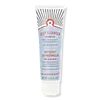What's inside
What's inside
 Key Ingredients
Key Ingredients

 Benefits
Benefits

 Concerns
Concerns

 Ingredients Side-by-side
Ingredients Side-by-side

Water
Skin ConditioningSodium Lauroyl Sarcosinate
CleansingCocamidopropyl Betaine
CleansingGlycerin
HumectantAcrylates/Steareth-20 Methacrylate Copolymer
PEG-120 Methyl Glucose Dioleate
EmulsifyingDipropylene Glycol
HumectantCamellia Sinensis Leaf Extract
AntimicrobialChrysanthemum Parthenium Extract
Skin ConditioningGlycyrrhiza Glabra Root Extract
BleachingBisabolol
MaskingRosmarinus Officinalis Leaf Extract
AntimicrobialAllantoin
Skin ConditioningAcrylates/C10-30 Alkyl Acrylate Crosspolymer
Emulsion StabilisingPanthenol
Skin ConditioningIllite
AbrasiveCaprylyl Glycol
EmollientPotassium Hydroxide
BufferingDisodium EDTA
Mica
Cosmetic ColorantTetrasodium EDTA
Phenoxyethanol
PreservativeCI 77491
Cosmetic ColorantWater, Sodium Lauroyl Sarcosinate, Cocamidopropyl Betaine, Glycerin, Acrylates/Steareth-20 Methacrylate Copolymer, PEG-120 Methyl Glucose Dioleate, Dipropylene Glycol, Camellia Sinensis Leaf Extract, Chrysanthemum Parthenium Extract, Glycyrrhiza Glabra Root Extract, Bisabolol, Rosmarinus Officinalis Leaf Extract, Allantoin, Acrylates/C10-30 Alkyl Acrylate Crosspolymer, Panthenol, Illite, Caprylyl Glycol, Potassium Hydroxide, Disodium EDTA, Mica, Tetrasodium EDTA, Phenoxyethanol, CI 77491
Water
Skin ConditioningHamamelis Virginiana Water
AstringentButylene Glycol
HumectantNiacinamide
SmoothingPolysorbate 20
EmulsifyingLeuconostoc/Radish Root Ferment Filtrate
AntimicrobialBackhousia Citriodora Leaf Extract
AstringentCamellia Oleifera Leaf Extract
AstringentCereus Grandiflorus Flower Extract
Skin ConditioningFicus Carica Fruit Extract
HumectantGinkgo Biloba Leaf Extract
Skin ConditioningHovenia Dulcis Fruit Extract
Skin ConditioningMalpighia Punicifolia Fruit Extract
AntioxidantGlycerin
HumectantAcrylates/C10-30 Alkyl Acrylate Crosspolymer
Emulsion StabilisingCitric Acid
BufferingSodium Hydroxide
BufferingBenzoic Acid
MaskingPotassium Sorbate
PreservativePhenoxyethanol
PreservativeParfum
MaskingCI 17200
Cosmetic ColorantWater, Hamamelis Virginiana Water, Butylene Glycol, Niacinamide, Polysorbate 20, Leuconostoc/Radish Root Ferment Filtrate, Backhousia Citriodora Leaf Extract, Camellia Oleifera Leaf Extract, Cereus Grandiflorus Flower Extract, Ficus Carica Fruit Extract, Ginkgo Biloba Leaf Extract, Hovenia Dulcis Fruit Extract, Malpighia Punicifolia Fruit Extract, Glycerin, Acrylates/C10-30 Alkyl Acrylate Crosspolymer, Citric Acid, Sodium Hydroxide, Benzoic Acid, Potassium Sorbate, Phenoxyethanol, Parfum, CI 17200
 Reviews
Reviews

Ingredients Explained
These ingredients are found in both products.
Ingredients higher up in an ingredient list are typically present in a larger amount.
Acrylates/C10-30 Alkyl Acrylate Crosspolymer is a synthetic polymer. It is used to thicken and improve the texture of products. Due to its properties, it can prevent water and oil ingredients from separating.
Glycerin is already naturally found in your skin. It helps moisturize and protect your skin.
A study from 2016 found glycerin to be more effective as a humectant than AHAs and hyaluronic acid.
As a humectant, it helps the skin stay hydrated by pulling moisture to your skin. The low molecular weight of glycerin allows it to pull moisture into the deeper layers of your skin.
Hydrated skin improves your skin barrier; Your skin barrier helps protect against irritants and bacteria.
Glycerin has also been found to have antimicrobial and antiviral properties. Due to these properties, glycerin is often used in wound and burn treatments.
In cosmetics, glycerin is usually derived from plants such as soybean or palm. However, it can also be sourced from animals, such as tallow or animal fat.
This ingredient is organic, colorless, odorless, and non-toxic.
Glycerin is the name for this ingredient in American English. British English uses Glycerol/Glycerine.
Learn more about GlycerinPhenoxyethanol is a preservative that has germicide, antimicrobial, and aromatic properties. Studies show that phenoxyethanol can prevent microbial growth. By itself, it has a scent that is similar to that of a rose.
It's often used in formulations along with Caprylyl Glycol to preserve the shelf life of products.
Water. It's the most common cosmetic ingredient of all. You'll usually see it at the top of ingredient lists, meaning that it makes up the largest part of the product.
So why is it so popular? Water most often acts as a solvent - this means that it helps dissolve other ingredients into the formulation.
You'll also recognize water as that liquid we all need to stay alive. If you see this, drink a glass of water. Stay hydrated!
Learn more about Water